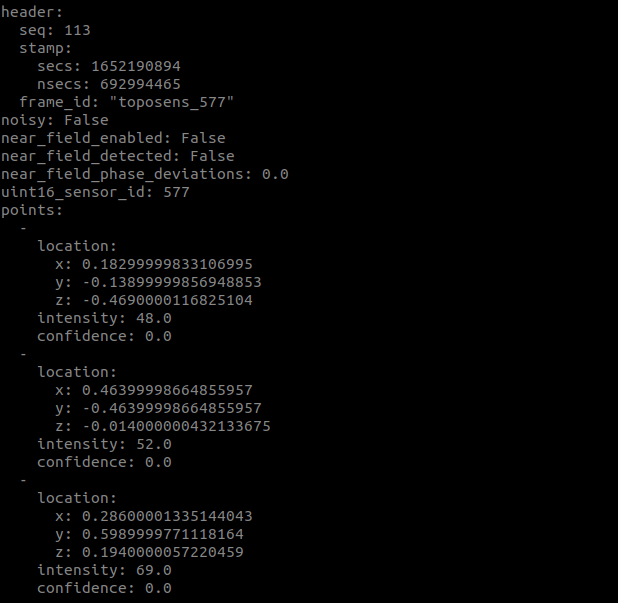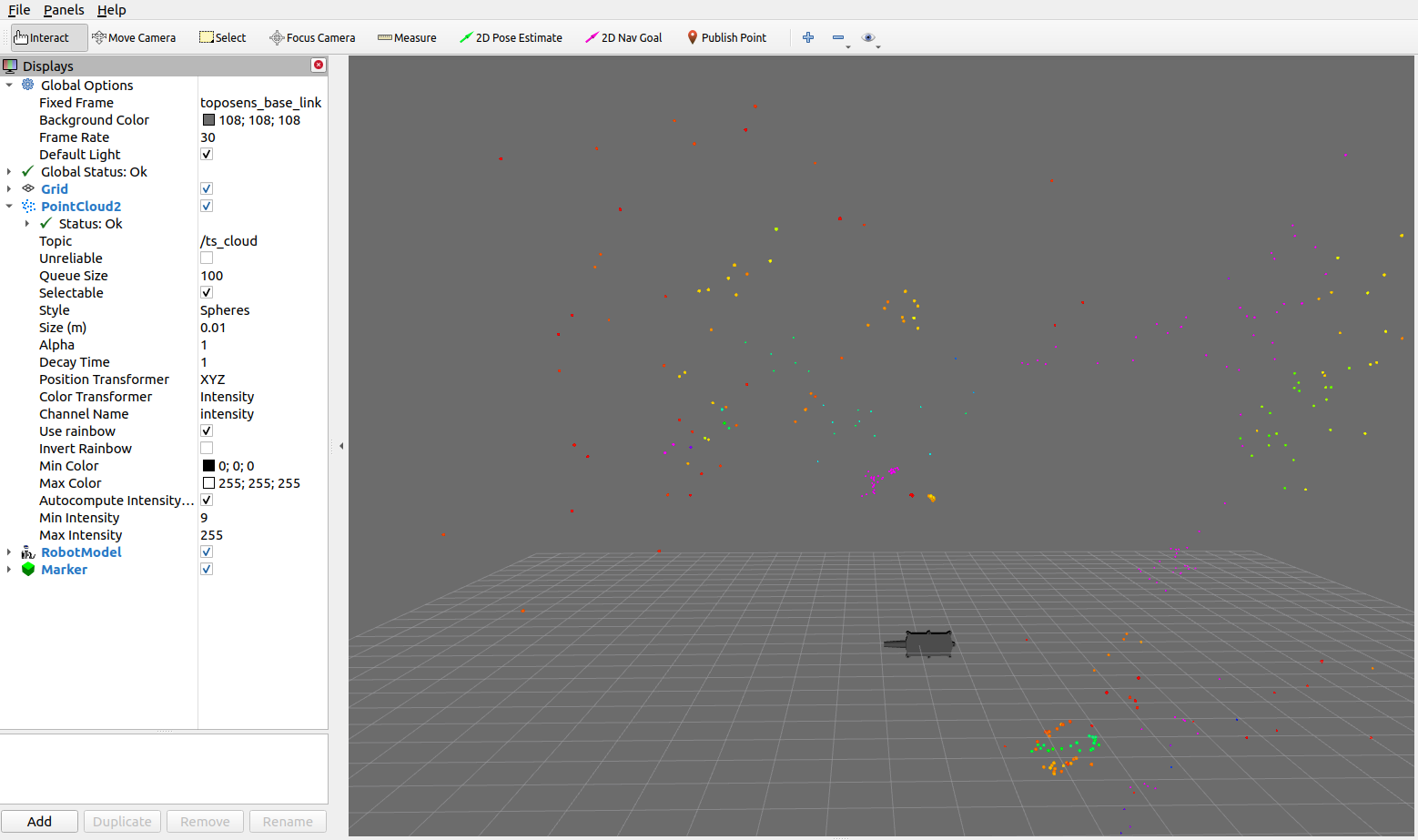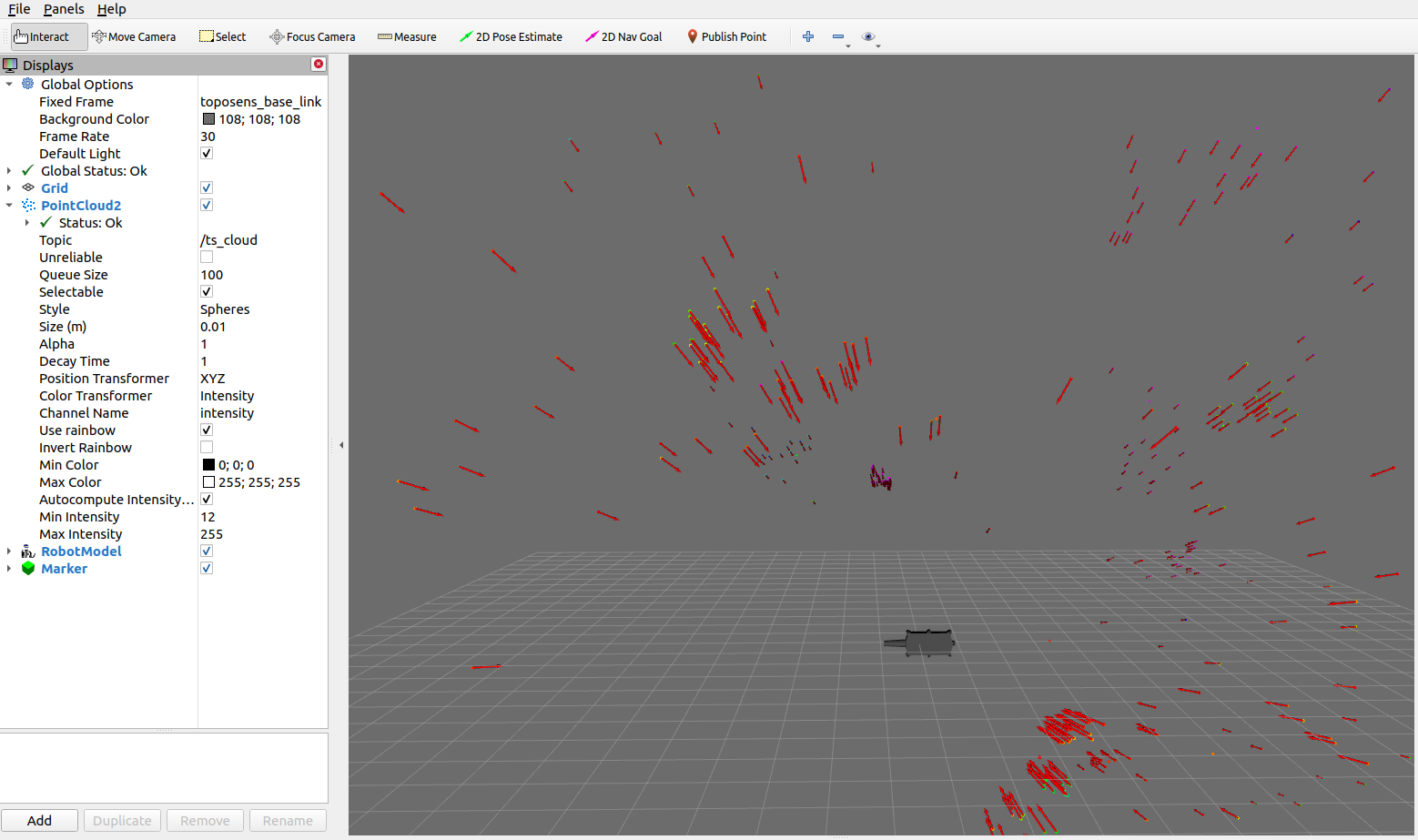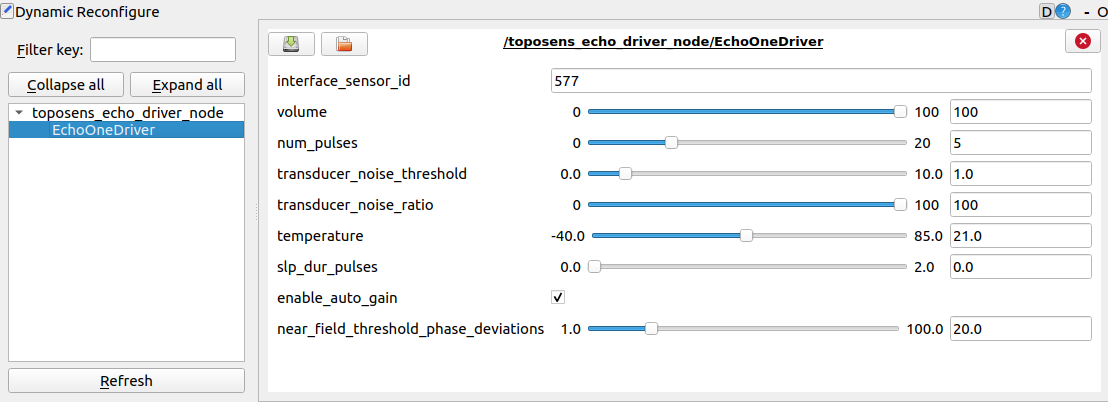|
Size: 8407
Comment: adding uart description.
|
Size: 8639
Comment:
|
| Deletions are marked like this. | Additions are marked like this. |
| Line 51: | Line 51: |
| == Visualize Data == | == Visualize Data with RVIZ == The command that most people should use to explore the sensor is below. This will set parameters, bring up rviz, and publish pointclouds. {{{ roslaunch toposens_bringup echo_one.launch }}} == What is Published == |
| |
Getting Started with ECHO ONE
Description: Using the Toposens stack to connect to and display data from Toposens 3D ultrasonic sensorsKeywords: Toposens, ECHO ONE, TS3, ultrasound
Tutorial Level: BEGINNER
Contents
This tutorial assumes that either Ubuntu 18.04 with ROS Melodic or Ubuntu 20.04 with ROS Noetic is used.
Install Driver
Currently the best way to install the Toposens ROS Software Stack is by downloading the software package from our toposens members site and following the instructions there to install the debians. AMD64 and ARM64 packages are available. In the future we will provide docker images in Docker Hub, but these images are currently out of date. Also, the software in the ros repositories is unfortunately out of date.
Connect ECHO ONE Sensor with CAN
The README of the toposens_echo_driver package provides instructions on how to enable the CAN interface for Ubuntu to be used with ROS.
Connect ECHO ONE Sensor with UART
UART is also supported as a communication protocol, but will be deprecated in the future. If you haven't yet, the user will need to be added to the dialout group to access serial communication:
sudo adduser $USER dialout
To use this protocol you will need to add a parameter to the roslaunch command, com_interface:=UART, for example:
roslaunch toposens_bringup echo_one.launch com_interface:=UART
Visualize Data with RVIZ
The command that most people should use to explore the sensor is below. This will set parameters, bring up rviz, and publish pointclouds.
roslaunch toposens_bringup echo_one.launch
What is Published
Point data from the ECHO ONE is published on two topics:
/ts_scans broadcasts messages of type toposens_msgs/TsScan, which hold the raw data stream parsed as toposens_msgs
/ts_cloud broadcasts messages of type sensor_msgs/PointCloud2, which can be visualized in RViz and used with the Point Cloud Library (PCL)
The utility of these topics is further explored in the following sections.
View Raw Stream
The toposens_echo_driver_node translates the sensor data into custom toposens_msgs/TsScan messages.
Launch the driver node to read data from ECHO ONE. If the interface obtained in the previous step is the default (can0 for ECHO ONE), then the launch argument can_device can be omitted:
roslaunch toposens_echo_driver driver.launch can_device:=can0
The sensor data is published to the the topic /ts_scans. View the incoming scans with:
rostopic echo /ts_scans

View Pointcloud in RViz
The ts_cloud_node translates the messages of type toposens_msgs/TsScan into messages of type sensor_msgs/PointCloud2.
Due to the specular reflection behavior of ultrasound, the surface normal of the detected object can be represented by a vector pointing from the detected point towards the sensor’s position while the point was recorded. This normal vector is added to the PointCloud representation. For a more detailed explanation of the physics behind Toposens sensors see Physics of 3D Ultrasonic Sensors.
The driver node as well as the pointcloud node are launched from within one launch-file (as before, interface defaults to can0 and can be omitted in this case):
roslaunch toposens_bringup echo_one.launch can_device:=can0
For also launching rqt_reconfigure set the launch argument:
roslaunch toposens_bringup echo_one.launch launch_rqt_reconfigure:=true
The pointcloud is visualized in RViz:

In order to visualize the surface normal vectors, run the launch-file with the corresponding argument:
roslaunch toposens_bringup echo_one.launch lifetime_normals_vis:=1.0

Be aware that in case of a static sensor (i.e. no tf information) the normal vectors are simply pointing towards the sensor at any time.
Reconfigure Parameters
To adjust sensor parameters at runtime, launch the dynamic reconfigure GUI:
rosrun rqt_reconfigure rqt_reconfigure
Make sure roscore and the toposens_echo_driver_node are running before launching the reconfigure gui (roscore is started when using one of the aforementioned roslaunch commands).
Sensor Parameters
There are several parameters that can be dynamically reconfigured in the toposens_echo_driver_node.

Variable Name |
Description |
interface_sensor_id |
The ID of the sensor you want to configure. This should be automatically configured to the currently connected sensor. In case of multi sensor setup please specify the ID of the sensor you want to reconfigure first, before adjusting any of the other parameters. |
volume |
Percentage determining the amplitude of the transducer pulse. Should be set to 100. Reconfiguring requires re-calibration of the sensor! |
num_pulses |
Defines the number of electrical pulses that the piezo transmitter is stimulated with in every transmission cycle. The higher the number, the louder and longer the emitted signal will be. As a result, increasing the value will detect objects that are further away, decreasing it will increase the sensor's precision in short range. Typically a value of 5 should yield good results. Reconfiguring requires re-calibration of the sensor! |
transducer_noise_threshold |
Controls the noise filtering of the sensor, i.e. very quiet points are already filtered out in the sensor's processing pipeline. If the value is 0.0 all points from the sensor are passed to ROS, a reasonably good value is 1.0. |
transducer_noise_ratio |
Sensor signal processing parameter that controls filtering of points on sensor side. A value of 100 disables the filtering and should be used, as this deprecated parameter is replaced with the confidence value of the point clouds which can be used for filtering. |
temperature |
This parameter defines the temperature that is used for calculating the speed to sound. Its accuracy has an effect on the correct calculation of the distance of objects. |
sleep_dur_pulses [experimental] |
Adds extra sleep after each measurement. |
enable_auto_gain |
The sensor amplifies the signal based on distance. This feature dynamically adjusts the amplification given the current signal and tries to avoid clipping of the signal while also amplifying quiet echoes. |
near_field_threshold_phase_deviations [experimental] |
Parameter used for handling of near field. This is currently deactivated by default, as this will change in upcoming firmware iteration. |







